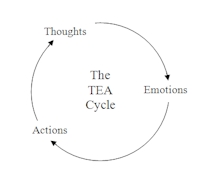Like most of us, you probably feel anxious or "stressed" in various areas of your life. In our fast-paced, competitive culture, these feelings are normal. In fact, some of the most high-achieving people report the highest levels of stress and anxiety!
However, these feelings can reach a point where they begin to interfere with work, sleep, and relationship patterns. Learning to manage stress and anxiety is an important skill.
When I work with clients on stress-management and anxiety-reduction efforts, I first try to make one thing clear: Anxiety is a normal response to challenges. People who are taking risks, trying new things in their lives, and growing in new ways will often feel anxious. Anxiety is a sign of growth. We all experience it in varying degrees.
Having said that, there are many approaches from the cognitive-behavioral therapy tradition that can help to reduce anxiety and manage stress in our lives. As with the treatment of depression, I often begin my work with clients by introducing what I call the "TEA cycle."
The idea behind the TEA cycle is that our Thoughts, Emotions, and Actions (T-E-A) can form an upward or downward spiral.
 Stressful and anxious thoughts can contribute to anxious emotions and lead to anxiety-perpetuating actions (including avoidance, a common behavioral response to anxiety).
Stressful and anxious thoughts can contribute to anxious emotions and lead to anxiety-perpetuating actions (including avoidance, a common behavioral response to anxiety).
This cycle can spin on itself over and over, creating a downward spiral. The anxiety-based thoughts, emotions, and actions reinforce each other, and keep each other in place.
In holistic cognitive therapy, we address all three elements of this cycle. We make changes to thoughts, emotions, and actions.
Interestingly, cognitive therapists have found some commonalities among people who are prone to high levels of stress and anxiety. These people often have:
Of course, each person is unique and everyone's TEA cycle is different. However, these are some elements that often show up in an anxiety/stress-oriented TEA cycle.
In cognitive therapy, we work on changing many of these elements. We shift perfectionistic, self-critical beliefs to self-accepting, self-supportive beliefs. We move the "balance-of-credit" for problems from overly personal responsiblity to shared responsibility. We identify catastrophizing thought patterns and replace them with more realistic thougth patterns.
We also emotionally face some of the "worst-case scenarios" and develop a "felt-sense" that we can handle even these scenarios. We develop new, self-soothing emotional patterns through relaxation and guided meditation practices. We begin to cultivate greater feelings of self-acceptance.
 Behaviorally, we work to develop new self-caring actions. We identify actions that aren't self-respectful, and strategize about how to replace them with self-respectful new actions. We build a holistic plan for stress/anxiety-reducing behaviors such as enjoyable daily exercise and social connection. We also work on specific issues that need to be addressed, such as work conflicts and relationship problems.
Behaviorally, we work to develop new self-caring actions. We identify actions that aren't self-respectful, and strategize about how to replace them with self-respectful new actions. We build a holistic plan for stress/anxiety-reducing behaviors such as enjoyable daily exercise and social connection. We also work on specific issues that need to be addressed, such as work conflicts and relationship problems.
The goal is to move the old anxious/stressed TEA cycle into a peaceful, self-respectful, self-accepting new cycle. The downward spiral can then change to an upward one.
Although everyone deals with anxiety and stress at times, other people experience more specific forms of anxiety.
The DSM, which is a book that psychotherapists often use to classify clinical issues, lists several specific forms that anxiety can take. These experiences are actually quite common; approximately 25% of people will fit the criteria for one of these types of anxiety at some point in their lives.
I have split descriptions of these onto separate pages. If you'd like information on any of these forms of anxiety, please click on the following: